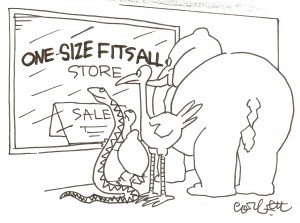Do You Provide a One-Size-Fits-All Approach?
Have you ever noticed that some organizations appear to have a one-size-fits-all approach to their: Customer’s Problems, Sales Campaigns, Marketing Campaigns and Collateral and Product Development? Why is that? Well, I believe that it is due to the lack of understanding of what their customers need. I believe that there is a lack of alignment between those sales, marketing and product development departments and their customers. Otherwise, why would they create and market their solutions that way? Often times we actually see solutions that can be molded to fit the specific needs of the client, but they are marketed in the same way to everyone.
Another thought that comes to mind is there are a lot of organizations out there that think their products or solutions can be everything to everyone! It’s those organizations that aren’t focused on what their target market is, or should be, and wind up confusing the market as to what they can do for them. Often times the reason this happens is that product development creates products in a vacuum, with no real face-to-face interaction with the people they are designing products for, to see if that is what they really want and need.
The same goes for Marketing when they create campaigns and promotional collateral that doesn’t connect with the buyer’s needs and concerns. These wind up alienating those buyers. Even those marketing materials intended as sales support are much more likely to be structured around generalized “messaging” on product benefits, not messages keyed to specific buyer needs and concerns at specific points on the individual path to purchase.
So, what happens is that the frontline sales people for those organizations lead with a generic pitch about their company and products. These pitches tend to have a heavy dose of here’s what we do and what our product does, in hopes that the prospect will immediately connect the dots around the products they have to the problems the buyers have. What usually happens is, they don’t.
Buyers don’t want a one-size-fits-all approach. Instead, they want to feel understood, because buyers buy because they feel understood, not because they understand. They don’t want to hear about your one-size-fits-all solution until they feel comfortable that you understand what their problem is. Then, once they feel understood, they will be more inclined to listen to what you have to say. When you get the chance to “say it”, make sure that you present it in a way that is specific to their needs, rather than we’ve got one product that solves everybody’s problems.
If you can change your sales, marketing and product development approach from a “one-size-fits-all” to one that is designed to fit a focused targeted market, where your customers feel understood and unique, then you will have a much more successful business.
At least that’s the way I see it, what say you?


